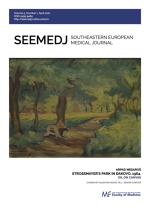Effects of Robot-assisted Upper Extremity Rehabilitation on Change in Functioning and Disability in Patients With Neurologic Impairment: A Pilot Study
DOI:
https://doi.org/10.26332/seemedj.v5i1.181Keywords:
robotics;, upper extremity;, International clasification functioning;, disability and health; , traumatic brain injuries; , strokeAbstract
Introduction: The aim is to evaluate the effect of robot-assisted training on the most important aspects of functioning and disability in patients with upper extremity neurologic impairment.
Materials and Methods: A prospective six-week pilot study included robot-assisted training of the upper extremity and conventional neurorehabilitation in 12 participants after a stroke or traumatic brain injury. Outcome measurements were range of motion (ROM), the International Classification of Functioning, Disability and Health (ICF) Core Set for Hand and the Visual Analog Scale (VAS) for pain sensation. A Wilcoxon test was used for the analysis of pre- and post-test differences and Spearman’s correlation was used for connecting the data collected.
Results: A statistically significant difference was found for ROM (shoulder abduction/adduction, shoulder flexion/extension, shoulder internal/external rotation and forearm pronation/supination) and a number of ICF categories (Body Function: b280, b710, b715, b730, b760; Activities and Participation: d230, d430, d440, d445, d5). A significant positive correlation of medium intensity (r=0.589) was found between the duration of movement coordination training and the ICF category b760. We did not find a statistically significant difference in pain sensation (VAS) with regard to the direct use of the device. For all analyses, p<0.05 and CI was 95%.
Downloads
Published
Issue
Section
License
Copyright (c) 2025 Southeastern European Medical Journal

This work is licensed under a Creative Commons Attribution-NonCommercial-NoDerivatives 4.0 International License.



